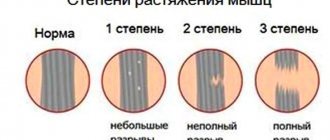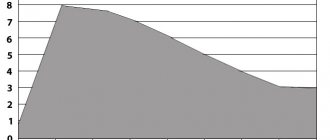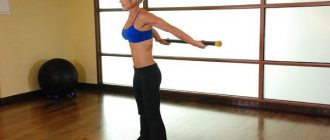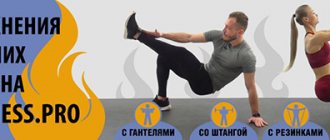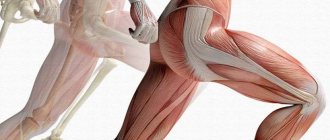Almost all people experience back muscle strains in their lives. Ligaments and muscles hold the vertebrae in the correct position, are responsible for the flexibility of the spine, for abducting the arms to the sides, etc. There are five large muscles and many small ones in the back; any of them can be damaged. Sprains in the lumbar back occur most often; in this place there is a muscle responsible for flexion and extension of the torso. However, you can stretch the ligamentous apparatus in any other department.
You should not think that back strain occurs only in adults; children are also at risk of such damage, because the back muscles of children are not yet strong enough to withstand heavy loads. During a sprained spinal muscle, it is very important to promptly identify an injury to the lower back or another part and begin treatment in order to protect yourself or a loved one from the consequences. Anyone who cares about their health needs to know about the symptoms and treatment of muscle strain.
Classification
When doctors talk about a strained back muscle, they mean a tear in the muscle fibers. In total, spinal sprains have three degrees of severity:
- The first (moderate) is a slight tear of individual fibers;
- Second (medium) - about fifty percent of the fibers are broken;
- Third (severe) - rupture of almost all fibers or complete separation of the ligament from the attachment point.
Sometimes a complete rupture of tissue in the lumbar region occurs during a dislocation of the vertebrae, in which case a combined injury occurs, which can carry the risk of damage to the spinal cord, and any spinal injuries can be life-threatening.
Causes
Partial or complete rupture of the ligaments of the lumbar spine can occur during muscle strain when lifting heavy objects, sudden bending of the body, unusual physical activity, as well as prolonged exposure to an uncomfortable position, for example, during sleep. In rare cases, a back muscle strain occurs when the sacral region is bruised during a fall on the tailbone.
The ligaments located inside the intervertebral space can be damaged at any age, but adults who lead a sedentary lifestyle are more susceptible to such damage. Under more or less serious load, their muscle fibers, unable to stretch, are torn. In children, this damage often occurs due to congenital underdevelopment of the muscular corset.
https://youtu.be/JiLWPvPeQwU
Symptoms
During back muscle strains, symptoms and their intensity will depend on the severity of the injury. Signs in the first degree can be barely felt, while in the third degree a person practically loses the ability to move the body. In order to treat a back muscle strain, you need to be sure of the type of injury. This can be done based on the following symptoms:
- Painful sensations. When a back muscle strain occurs, pain is the first sign of injury. With a mild degree, the pain will be absent at rest and will appear moderately during body movements. As a rule, pain during a mild sprain is localized directly at the site of muscle fiber rupture. With a more severe degree of damage, pain is felt both during body movements and in a calm state. It becomes more pronounced when bending and turning the body, as well as during palpation, and spreads over a larger area.
- Limitation of mobility. A person with such an injury cannot fully bend and turn the body, as this leads to increased pain. With severe damage, the ligaments and muscles of the back generally lose their functionality, and the victim remains bedridden almost until the completion of treatment.
- Swelling at the site of injury. The inside of the muscle tissue is filled with fluid; when the fibers tear, this fluid leaks into the surrounding area, which causes swelling. The location of the stretch becomes firm to the touch and swollen. When the muscles are completely torn, very large swelling occurs.
- Hematoma. As a rule, with a minor sprain there is no bruise, but if the ligament or muscle is completely torn, then a large bruise appears on the back.
I have selected the following prevention methods for you:
- Before you lift anything or perform any strength exercise, be sure to warm up your muscles. No sudden movements needed.
- Don't sit in one place, lead an active lifestyle. Then problems with muscle tears can be avoided. The body will be ready for stress.
- Don't flatter yourself or show off to your friends or girls that you can lift a lot of weight right away, without training!
- Go to the pool, because swimming relieves stress on your back.
Well, the most important advice here is to take care of yourself and your back! ?
That's it, dear reader. When playing sports, you should always think about your safety. Our body is, of course, ready for loads, but only correctly selected ones, with gradual complication. Don’t rush to get a high result and take on a new weight, methodically go towards your ideal and everything will work out for you!
https://youtu.be/f3HduY6U7Yw
First aid
Without a preliminary examination, you cannot treat a sprain on your own, but before the doctor examines the victim and prescribes therapy, it is necessary to provide the victim with first aid. Even with a slight sprain, the victim should stop moving, lie down on the bed and relax. With continued physical activity, a minimal stretch can turn into a complete rupture of muscle tissue.
To alleviate the condition of a person who has been injured, a cold compress should be applied. To do this, you need to take ice from the freezer, or any frozen product from there, wrap it in cloth and apply it to your back.
Under no circumstances should cold be applied to a naked body, as this can cause frostbite to the tissues.
For the same reason, you cannot keep the compress for more than half an hour. After four hours it will be necessary to repeat this manipulation again. The cold will prevent a large hematoma from protruding and inflammation from spreading, which will reduce the risk of severe swelling.
If it is clear that a hematoma is already beginning to appear, then you should use a pressure bandage, that is, wrap the injury site with an elastic bandage. It is worth considering that when stretching the muscles of the thoracic region, the bandage should be applied so that it does not impair the victim’s breathing. It is necessary that the area in which the stretching occurred is slightly elevated, otherwise the swelling and hematoma will spread to the nearest tissues. To prevent this, you should place a soft cushion or small pillow under the injured part of your back. Before consulting a doctor, it is advisable not to take any painkillers, as this may blur the clinical picture and complicate diagnosis.
After treatment
When a positive medical result is obtained, pain and discomfort are removed, this does not mean that you can begin to carry heavy loads with the same enthusiasm. In order not to repeat mistakes and become a victim of a broken back again, you need to follow certain rules and not forget about prevention.
Advice. Be sure to take note, if your job involves this activity, of guidelines on how to lift weights correctly.
In order to no longer break your back, you need to approach the process of lifting and carrying weights competently. Parameters such as the angle of lift, its speed, body position, and the degree of muscle preparedness are important.
- You cannot lift a load while standing on straight legs and bending your back. First you need to half squat.
- You cannot take something heavy and only turn your torso; the whole body must turn.
- Before lifting weights, it is necessary to bring the muscles into a warm state.
After the attack is relieved and the functioning of the muscular system is normalized, the patient must reconsider his lifestyle. In the future, it is necessary to avoid repetitions of the painful situation and take actions to strengthen the spinal muscles.
You can regularly engage in any or several types of physical activity:
- exercises, including planking and strengthening the abdominal muscles;
- a set of exercises that improves posture;
- yoga;
- swimming.
Important! You should not lead an inactive lifestyle and limit mobility, otherwise the muscles will atrophy, and a new breakdown will occur after receiving a much lesser load. Reasonable progressive physical activity, and constant one at that, is indicated.
A torn back always seriously disrupts the usual course of life. But if the phenomenon is ignored, has become habitual, is constantly removed with improvised means and not completely, then you can get chronic diseases of the spine, which can turn a person into a disabled person. That is why it is necessary to immediately seriously treat a torn back, bring the process to a complete result, and try to ensure that the situations that provoked this disease do not recur in the future.
Video – Broke your back at the dacha?! How to keep your back healthy
https://youtu.be/axW2t0SAuaM
Establishing diagnosis
In order to determine the type of damage, the doctor interviews the patient. Knowing the mechanism of injury helps the doctor to suspect the presence of muscle tissue strain. After the interview, an external examination and palpation of the damaged area begins, as well as testing of tendon reflexes. The doctor always asks what the nature and location of the pain is. With local pain, a first-degree sprain can be assumed. If the pain syndrome spreads to the thigh, groin, buttocks, then damage to the nerve endings is possible.
The patient must undergo an X-ray to rule out an injury such as a spinal fracture. In order to examine in detail the vessels, nerve processes and muscle tissue itself, computed tomography or magnetic resonance imaging is performed. Only after undergoing a full examination can the doctor make a reliable diagnosis and decide how to treat the patient based on the severity of the sprain.
Therapeutic measures
Since a minor sprain does not manifest itself with pronounced symptoms, people often do not seek help from a doctor and begin to self-medicate with traditional methods. It is highly not recommended to do this before the examination and without consulting a doctor. Traditional medicine can only be a supplement to the main treatment prescribed by the doctor, but cannot completely replace it.
Symptoms and treatment depend on the severity of the injury. Basically, doctors carry out conservative therapy, resorting to surgery only when the muscle is completely torn. Treatment for a sprained back muscle is as follows:
- Bed rest. During the acute phase of stretching, the patient should remain calm and not make sudden movements.
- Taking medications. The doctor prescribes painkillers to the patient. They are not able to cure a sprain, but they are good at eliminating pain and stabilizing the patient’s condition. Anti-inflammatory drugs are also prescribed. It is reasonable to take both of them for no longer than two days during the acute period, after which there is no need for this. The use of Ibuprofen and the use of Diclofenac are rational. On the third day, the doctor prescribes warming agents and compresses, for example, Heparin ointment.
- Physiotherapy. Starting from the third day, it is advisable to undergo physiotherapeutic procedures. After swelling subsides and pain is relieved, electrophoresis, magnetic therapy, paraffin baths and UHF heating are prescribed. A visit to the pool and sauna gives good results, but only with the permission of the treating doctor.
- Massage. It is recommended to have a massage from a specialist who knows exactly how hard and where to press so as not to cause harm. Massage helps improve blood circulation at the site of the sprain, which promotes faster recovery of muscle tissue.
- Acupuncture. This procedure helps to remove the hematoma and relieve swelling, but it is worth remembering that it should only be carried out by a highly qualified specialist.
- Exercise therapy. You can start physical therapy exercises only after the doctor allows more or less active movements, but you should not overdo it right away. You need to start with light exercises, for example, raising the pelvis while lying down. The “cat” exercise helps to develop your lower back well. Standing on all fours, you need to bend your back and arch it upward.
Along with the main treatment, the doctor may recommend treatment with folk remedies, for example, warming alcohol compresses.
How to treat a torn back?
Only a doctor can prescribe adequate treatment after examination. “To treat back pain, it is better to consult a specialist - a neurologist or a sports doctor if you are actively involved in sports. Only they will be able to correctly determine the cause and give competent recommendations. In the simplest cases, I use kinesio taping; this method is accessible and effective; it is also useful to perform myofascial release using a roller or tennis ball. Anti-inflammatory or painkillers should be taken only as prescribed by a doctor, since there are serious contraindications to their use, for example, stomach ulcers and even simple gastritis, says Alexander Kolesov. — Physiotherapeutic treatment is often effective for back pain, but it is prescribed by a physical therapist. Surgical treatment is indicated only in the most difficult cases, prescribed by a neurosurgeon and only when other treatment methods have proven ineffective.”
